Everything You Need To Know Before Jogging With A Running Pram
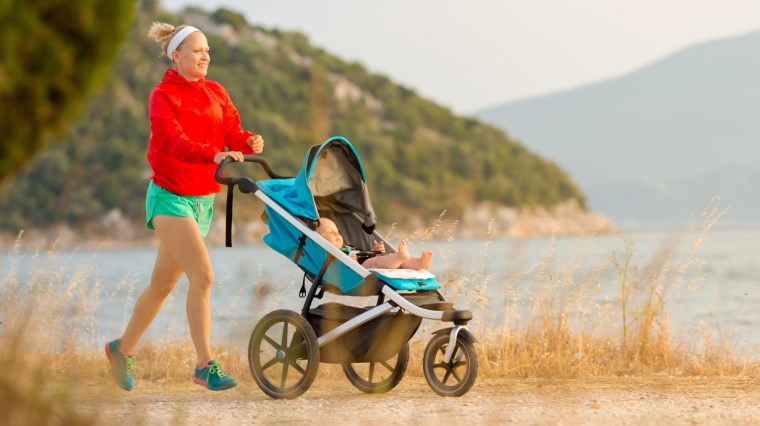
Including your baby in your passion for running has numerous benefits to both you and your little one. With your world turned upside-down with a new little human on board, anything that can make exercise more practical and plausible is well worth the effort. A running pram is designed to do just that – allowing you to balance your fitness with your family life.
No doubt you’re excited to put an end to your running hiatus postpartum by springing into your jogging stroller sessions, but there’s some important questions you need to ask before pounding on the pavement with your precious cargo in tow. These common running pram questions will help debunk any misconceptions, keep you motivated and help your little athlete stay safe on you next running adventure.
Is a running pram worth it?
For active parents, absolutely. In the same way that you wouldn’t use your everyday sneakers for running, you shouldn’t use your regular pram to clock up high mileage or move swiftly on the pavement – it’s a matter of both your baby’s safety and comfort.
Running prams have features for just that – running (and jogging) - but some have adaptable designs that can be used for everyday pram adventures just like a regular stroller.
Running prams are 3-wheeled with 1 wheel at the front and 2 wheels at the back to improve manoeuvrability when setting a brisker pace. Air-filled rubber tyres provide shock absorption to soak up impacts and smooth out any bumps, but like your bike tyres the air pressure needs to be checked and they run the risk of punctures. When you weigh up that extra maintenance with the freedom a running pram provides, for many fitness-loving parents it's an easy choice.
What safety features should I look for in a running pram?
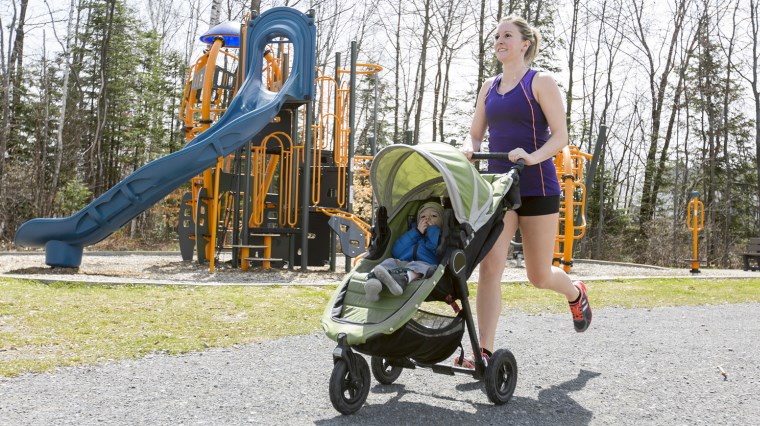
Essential safety features like a 5-point harness keep your baby safe and secure and a handbrake helps you stay in control, particularly when running downhill so you don’t have to use your body as a brake.
Prams are usually categorised as having either a fixed front wheel or swivel front wheel. A fixed front wheel provides stability when moving quickly, preventing potentially dangerous wobbling and keeping your pram gliding along in the desired direction.
Alternatively, a front wheel with swivel capability gives you the best of both worlds – offering practicality and easier steering at a walking pace like when you're shopping, but can be locked into a fixed position to boost safety when you’re looking to increase speed.
How old does my baby need to be before using a running pram?
It’s recommended that your baby be at least 6 months old before harnessing them into a jogging stroller and hitting the road. At this stage, most babies have developed the neck strength and control to hold their head up, but every child is different.
It may take as long as 8 months for them to be running pram ready and capable of tolerating any bounces and bumps in the road without injury – so be sure to seek the advice of your child’s paediatrician.
Is it harder to run with a running pram and does it burn more calories?
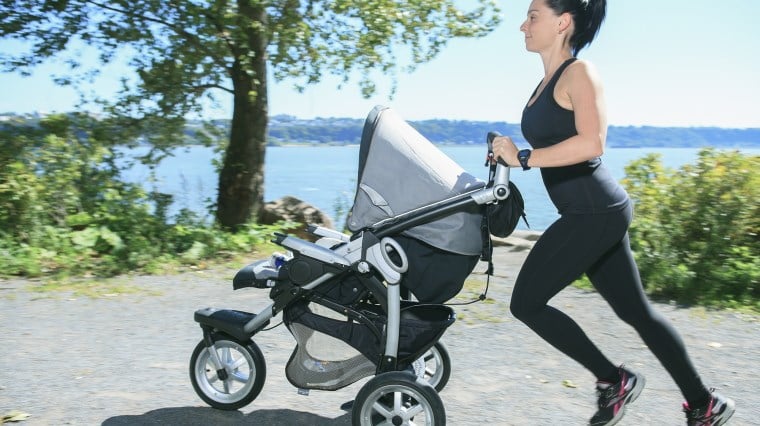
Yes, it is harder but don’t let this deter you. In fact, you should wear it as a badge of pride. Running with a pram not only offers a cardio workout and gets your legs moving like solo running, but it burns more calories versus running without the pram - meaning you can achieve a more intense workout at a slower pace. Keep in mind that the running pram itself likely weighs more than 10kg, not to mention the weight of your growing baby and necessities.
Even though running with a pram can be intimidating to new parents, they are designed to move with minimal resistance and glide with you – so even though the weight may sound like a lot, the actual effort or force you need to apply to get your running pram moving is less than you may expect.
Once you’ve put our running pram posture tips into action you’ll feel like a pram running pro, be stronger for it and find that your solo running sessions are absolutely freeing in comparison.
Can I still set the same running pace?
For experienced runners, it’s important to change your expectations of pace. It can be disheartening comparing your solo running pace with your running pram pace – but they’re truly in different worlds so it’s important to redefine your vision of success.
Doubling up feel-good, calorie-burning outdoor exercise with cherished bonding time between you and your little athlete is its own achievement. Keep in mind that running pram workouts put a greater demand on your legs to propel the weight forward so if you choose to race yourself, only compare your running pram time with previous running pram times.
Stay mindful that it’s a team effort and that your little human won’t always be the most cooperative running companion, particularly on cheeky or grumbly days where you may need to break your momentum to soothe them or to retrieve a runaway toy.
Where’s the best places to run with a pram?
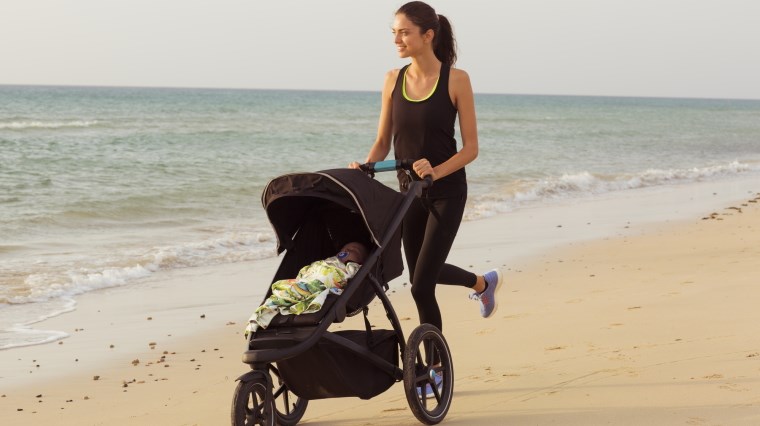
Safety first – for the most enjoyable, worry-free experience choose peaceful, quiet streets or parks with wide paved paths during the day. Damaged, cracked footpaths can be a bit of a nightmare for new pram runners so gravitate towards surfaces that are smooth for easy rolling.
You can push your running pram uphill, but it’s best you graduate to this once you’ve had experience and gained confidence on flat surfaces at a brisk pace. When you’re a more experienced stroller runner, you may even consider trail running.
Make sure you get the right running stroller for the right job - all-terrain strollers are specifically designed with features like wide, high traction tyres to tolerate stones, roots and other natural debris and some are even capable of moving on sand. Do your research to find stroller-friendly running trails near you that you know well before packing for your next adventure with your precious cargo in tow.
How long should my running pram workouts be?
It’s best to leave your endurance runs to solo running, at least until your well-practised using a running pram and know what to expect of your little athlete on the go. Running with a pram is a challenge and to keep you, your body and your little one happy it’s important not to overdo it – keeping in mind that babies can become overstimulated.
It may help to have a goal distance in mind of about 3km to 6km - that way if you have to cut your run shorter, you won’t beat yourself up. Pram runs over 6km are best for running with your spouse or a good friend that can alternate pushing the running pram with you.
When is the best time to take my baby for a pram ride?
It both pays to be flexible and to time your runs right, which can take some trial and error as a new parent. Babies are usually their most content and the least fussy with a full tummy, making after a feed the perfect time to harness them in and stimulate their senses by the sights, sounds and scents of the outdoors.
Alternatively, scheduling your running pram runs with naptime can give you the freedom to run for longer while giving your little one a healthy dose of shut-eye on the go. Being able to fall asleep outdoors can help strengthen your child’s adaptability and give you some well-deserved me-time on the road.
Many babies are naturally soothed by the rolling motion as it mirrors the sensation of being in the womb. However, it’s also beneficial to acclimatise your baby to being able to self-soothe without the need of the calming movement.
How should I dress my baby when running with a pram?
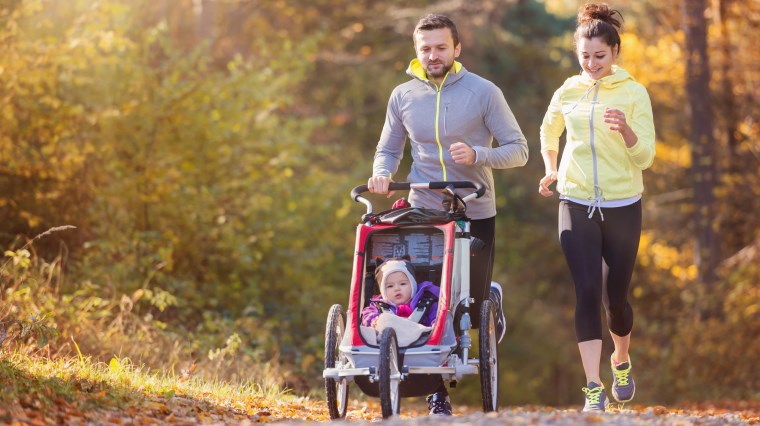
As a parent it can be tricky to gauge what your child should wear to stay cosy and comfortable based on the weather. Remember when pushing them with a stroller, you are the one exerting the effort, so it’s reasonable for you to wear your go-to running gear like running shoes, performance tights, sweat-wicking top and to layer in cold weather.
On the other hand, your child (unless they’re super wriggly!) will be relatively still so consider how you’d dress them on a normal outing, keeping the conditions in mind.
Again, layering is key – it’s easy to drop a layer if the temperature heats up and to tuck it away in your running pram’s storage basket or pockets. In cold weather, a onesie with attached booties is a perfect first layer for keeping tiny feet warm without potentially losing a sock. Pair it with baby beanies and mittens that can be easily removed if the weather heats up.
In warm weather, light and loose-fitting clothing will help keep your little one cool but it’s always a good idea to be overprepared rather than underprepared.
How can I protect my baby from the elements?
For your baby’s comfort and safety, it’s important to consider the elements. Pram weather covers can provide all year-round protection - blocking out the wind generated from your movement, keeping your baby dry during rainy runs and providing shade to shield them from glare on sunny days while offering ventilation.
Avoid using a blanket as a sun shield as this may result in overheating and blankets can run the risk of becoming tangled in the wheels. Don’t forget to apply kid-safe sunscreen to children 6 months and up no matter the season and to top their outfit off with a hat.
When should I graduate my child from a running pram?
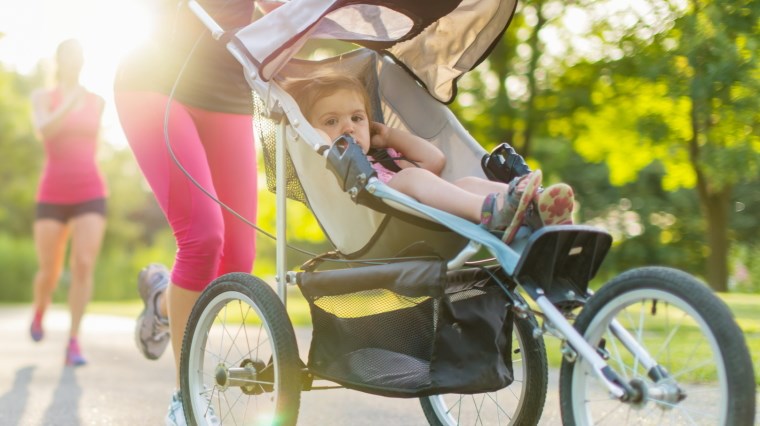
Apart from the weight restrictions of running prams and potentially outgrowing the canopy, there is no cookie-cutter answer of when to ‘graduate’ your child from pram life, being both an exciting and daunting milestone for parents. Like any transition, it’s a gradual process and is different for every child.
Eventually your child may need a kind-hearted nudge to know that the world is more fun standing on two feet but including them in exercise at a young age with a running pram sets the foundations for an active lifestyle.
Running prams, particularly those with multi-sport function make exercise more accessible to parents and many are suitable for family adventures even as your child grows. The Thule Chariot Sport bike trailer for example is capable of converting between a running pram, regular pram and bike trailer, allowing a child up to 22kg to ride along behind you safely.
Combining these experiences that reinforce the joy of the outdoors with opportunities of moving their legs like mum or dad can spark a sense of independence and allow toddlers and young children to interact with the environment in a positive way.
Happy running!
